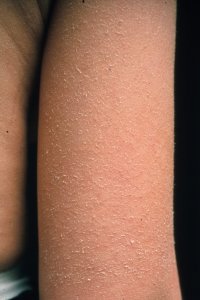Ichthyosis vulgaris

This is the most frequent type of ichthyosis and probably the most frequent genetic disease in the general population. Prevalence of the disease in the general population is about 1 : 300 inhabitants.
The clinical disease mostly starts in infancy. As a general rule neonates do not yet exhibit typical features. In infancy, the skin turns dry and rough and the skin surface is covered by small to mediate-large whitish or greyish scales.
In more marked cases, the scales get larger and thicker and turn darker. Skin may even get a rhombic appearance. Typically the extremities are more severely affected than the trunk or the face. Mostly, the dorsal surfaces of the legs are involved. It is typical for this disease that it spares the major body folds like elbow creases, axilla, inguinal region and the popliteal folds. Palms and soles show accentuated creases and when affecting the palms this sign is referred to as palmar hyperlinearity or as “ichthyosis palms”. This palmoplantar hyperlinearity is very typical of ichthyosis vulgaris, but by no means specific. It can likewise be noted in several types of ARCI.
A further feature are follicular keratoses very often on the dorsal surfaces of the upper arms or on the lateral aspects of the upper legs. Sometimes patients suffer from mild pruritus and mild hypohidrosis (inability to perspire).
Ichthyosis vulgaris is often accompanied by atopic dermatitis. The reason for this is the lack of filaggrin. IV is due to mutations in the gene profilaggrin encoding the protein filaggrin. This protein has many subunits which among else are responsible for the moisture of the skin (natural moisturizing factor).
In many cases skin changes in ichthyosis vulgaris can be quite variable and often show only a minimal expression so that the disease can often not be noticed by the quick observer. Affected persons with a clear-cut type of ichthyosis vulgaris mostly harbor two FLG mutations while mildly affected persons usually have only one FLG mutation. As persons having only one mutation do not always develop signs of ichthyosis the inheritance pattern is considered to be "semi-dominant".
